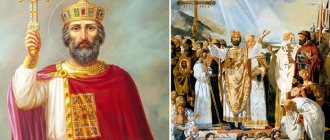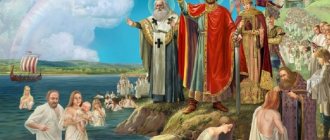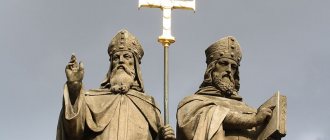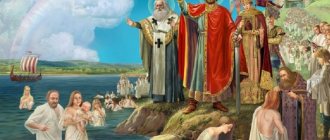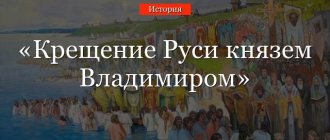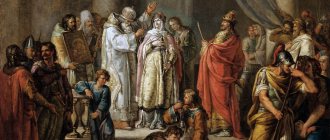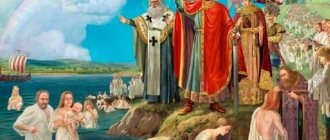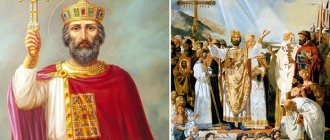The Baptism of Rus' is the adoption of Orthodox Christianity as the state religion in Rus', which occurred in the summer of 988 (according to modern chronology). The holiday “Day of the Baptism of Rus'” is July 28.
It is believed that Rus' was baptized by Prince Vladimir Svyatoslavovich.
“The Baptism of Rus'”, artist K. V. Lebedev, 20th century.
At what year?
According to the chronicle, Vladimir himself was baptized in 988.
In the same year, 988, a long process of acceptance of the faith by the Eastern Slavs began - but its final “point”, when Rus' truly became “Holy”, Orthodox, is difficult to determine.
Did it emerge Christian , having been tested, like gold in a crucible, from the timelessness of Mongol rule? Should we consider the existence of Christian Rus' since the 14th century, when St. Sergius of Radonezh? Or maybe from the 16th century, when the word “peasant” first appeared, what does “Christian” mean? Is this what rural producers call themselves, putting faith rather than their work at the forefront? The issue has definitely not been resolved to this day.
Is the exact date of the event known?
No. History has not preserved the day or month.
What kind of faith was there before Baptism?
It is defined as the so-called pagan, from the Slavic “language”, or “people”. This suggests that the faith of the Slavs was determined by a kind of collective experience of understanding the world and nature. Very little data has been preserved about the paganism of Rus'. They are given:
- data from ethnographers, back at the beginning of the 20th century. who observed some rituals dating back to paganism; elements of a long-gone faith preserve the traditions of embroidery patterns and features of Slavic clothing;
- research by folklorists who wrote down not only songs, riddles, proverbs, but also many fairy tales containing elements of the pagan Slavic worldview;
- finally, Russian chronicles report some names of Slavic gods and some details about rituals.
The main features of religion include:
- polytheism;
- magic, when the basis of interaction with nature, spirits, and gods are various types of magical practices.
Choice of Faith
Historians of different generations agree that Saint Vladimir settled on Orthodoxy for a reason - it was the result of a conscious choice. There is a beautiful legend about how Prince Vladimir chose Christianity according to the Orthodox, Byzantine rite. Preachers of the main faiths were invited to the court of the Kyiv prince: Judaism, Islam, Western and Eastern Christianity. Allegedly, the last argument in favor of Orthodoxy was the impressions of the Russian ambassadors who were present at the service in the Church of St. Sophia of Constantinople. Most likely this is a fairy tale, but as they say: “a fairy tale is a lie, but there is a hint in it...”.
Are you an expert in this subject area? We invite you to become the author of the Directory Working Conditions
The truth is:
- The choice of faith was not a spontaneous decision, it was a conscious decision determined by the prevailing internal and external situation;
- Prince Vladimir was familiar with the basics of the Christian religion, the upbringing of his own grandmother, the Holy Equal to the Apostles Princess Olga, had an effect, there were Christian communities in the country, and there were Christians in the prince’s squad.
- Vladimir desperately needed support both within the state and from outside. The Christian Church would ensure unquestioning submission to the power of the prince within society, and the support of Byzantium would guarantee prestige on the world stage.
When did Christianity appear in Rus'?
It is known that the Christianization of Europe began already in the 1st century, and the Slavs came to the East European Plain from this region. With a high probability we can say that faith was at least known to them. Russian chronicles indicate that at least from the 9th century. Among the princely warriors there were many Christians. It is traditionally believed that they were also the Kiev princes Askold and Dir (late 9th century)
Askold and Dir in Constantinople (chronicle miniature)
A new stage in the spread of faith begins under Princess Olga, who is the first of the Russian princesses to receive the Sacrament from the hand of the Patriarch of Constantinople. However, the Christianization of Russia under the princess is hampered by both the position of the majority of the population and the desire of Byzantium, where the princess more than once turned with a request to form a diocese and send priests. The empire had in mind political benefits from the Christianization of such a large territory and wanted to gain control over trade routes.
Pagan beliefs of Rus' before the adoption of Christianity
By the end of the 10th century, Kievan Rus stretched from the Baltic Sea to the Black Sea and from the Bug to the Oka. From the West, Rus' bordered on Catholic Poland and Hungary, from the East - on Muslim Bulgaria, from the South-East on Jewish Khazaria, from the South - on Orthodox Byzantium. Rus' remained pagan.
The collection of gods of Ancient Rus' included more than a dozen Elder gods and even more Younger ones. These included the spirits and guardians who inhabited all areas of the lives of our ancestors. Spirits lived everywhere: in the house, barn, forest, river. They were the ones who were responsible for the harvest, success in hunting, and the well-being of the family. They brought demands, asking for help in all matters, from the fateful to the daily. The prince and his squad (Perun), the cattle breeders (Veles), the women (Mokosh), etc. had their own gods. Many gods were similar to the deities of their neighbors - the Baltic, Western and Southern Slavs.
Why Princess Olga failed to instill faith in her son Svyatoslav
First of all, because at the time of the spiritual rebirth of the pagan princess, who became a Christian, he was an adult, an established personality. At the same time, the prince:
- had state views that were different from those of his mother: while Olga cared about the spiritual unity of the country, Svyatoslav was more interested in conquering new territories, controlling trade, and making a profit;
- like any prince, he was heavily dependent on his squad, most of which were pagan; Svyatoslav seriously feared that internal conflicts would not give him the opportunity to continue effective military campaigns.
For these reasons, respecting his mother’s beliefs, the prince did not share them, remaining an adherent of paganism until the end of his days. At the same time, the chronicler, speaking about Svyatoslav, does not utter a word of condemnation; on the contrary, he admires his military talents, courage, and honesty: of course, in his own way he was an integral, sincere person who was just as sincerely mistaken. However, Svyatoslav apparently never forbade his mother to raise his children – Olga’s grandchildren – Christianly.
“Olga’s Baptism” – art. S. A. Kirillov, 1993
Why did Prince Vladimir decide to accept Baptism
It is known that initially he did not have such intentions: fighting for the grand-ducal throne with his brothers, the prince appealed to the “fatherly faith.” Later his position changes.
List the main reasons
These include, first of all, political ones:
- most of the European states (including the Slavic countries culturally close to Rus' - Bulgaria, Moravia, etc.) had adopted Christianity by this time; military, economic, and political contacts were greatly hampered due to the confessional factor;
- Vladimir could not help but see that paganism, based on the veneration of tribal deities, was politically dividing the country; a common spiritual basis was needed; the prince’s attempt to forcibly establish the cult of the god of warriors Perun completely failed: the population simply did not accept this “reform”;
- finally, having a territory, as well as an economic potential comparable to Byzantium, Russia, since the time of Olga, had well-defined great-power ambitions, which were hindered by... Russia itself, spiritually divided, torn apart by tribal strife, while Christian Byzantium was at that time the only world power ; the choice of faith seemed quite obvious.
In addition to these, Vladimir also had personal motives. Perhaps it:
- the sacredly preserved memory of Olga, for whom the respect of the elite and the people was extremely great;
- the presence of Christians within the squad of the prince himself; many suggest that he was especially shocked by the death of the best warriors, the Varangians Theodore and John , who preferred death to participation in sacrifice to demonic forces, as Christians called “gods”;
“The first Christian martyrs under St. Vladimir” Painting by Pavel Sorokin. 1852, 1852 Canvas, oil. Size: 179.5 x 225 cm. Tretyakov Gallery
- finally, the personal appeal of Vladimir himself is shrouded in secrecy; the chronicler describes this, saying that the prince suddenly lost his sight on the eve of the Sacrament, and regained his sight in the font; This is a metaphor, or we are talking about a real miracle, but the prince’s personality after accepting the faith changed beyond recognition.
The prince who baptized Rus'
Here is the prayer of Prince Vladimir at the Baptism of the Kievites, and yet he could then be considered only a novice:
“God, who created heaven and earth! Look at this new people, and let them lead you, the true God, as you led the countries of the peasants, and establish in them a faith that is right and incorruptible, and help me, Lord, against the opposing enemy, so that, trusting in you and in your power, I will escape the intrigues his".
Why was Rus' baptized?
The prince believed that the new faith provided the foundation for the future spiritual unity of the Russians. That is why he did not limit himself to the personal acceptance of Christianity , but was actively involved in educating not only the political elite, but the entire population.
Equal to the Apostles Prince Vladimir. Part 2: Baptism of Rus'
Start
| Holy Equal-to-the-Apostles Grand Duke Vladimir |
The murder of the Varangian confessors Theodore and John made a strong impression on Prince Vladimir.
He began to think more often about questions of religion and gradually cooled more and more towards paganism. Where sin abounds, there, according to the apostle, grace abounds (cf. Rom 5:20). The advantages of the faith of Christ became more and more obvious to him, especially since in Kyiv itself there were quite a lot of Christians among the boyars, merchants, townspeople, and even princely warriors, starting from the time of Askold and Olga. Byzantium tried to convert the Russians to Christianity from the moment it began to be attacked by them. But the first, usually Varangian, principalities in the Black Sea region were not distinguished by their durability, and the achievements of Christian missionaries turned into nothing along with the collapse of the principalities themselves.
Princess Olga, having been baptized, tried to establish a bishopric in Kyiv, but failed. The Varangian squad recognized the authority of their co-religionist leader and refused to submit to the Christian prince. For the warrior prince Svyatoslav, the opinion of the squad was law, and he decisively rejected all his mother’s offers of baptism.
Prince Vladimir had to overcome great difficulties before Rus' accepted Christianity. In the second half of the 80s of the 10th century, he began to take the first, still very cautious steps leading to baptism.
Vladimir owed a lot to the pagans. He generously thanked them, but felt very shy under the control of the pagan elite and the Magi. They hindered his creative activity. With his military victories, construction successes within the country, and wise diplomacy towards neighboring states, Vladimir strengthened the role and importance of princely power and no longer tolerated rivalry. Already from the second half of the 80s, the pagans lost their leading role in Kyiv.
But Vladimir did not immediately agree to introduce Christianity. The chronicle “Tale of the Test or Choice of Faiths” describes that he first met with envoys from other lands and asked them about monotheistic religions - Islam, Judaism, Roman and Byzantine Christianity. This was not accidental: monotheistic religions grew from the same root, moreover, Rus' had close ties with Christian countries - Germany, Byzantium, Rome, and Muslim countries - Volga Bulgaria, Khorezm, as well as contacts with Jewish communities in Khazaria and on the territory of Rus' .
Having refused the first three embassies for various reasons, Vladimir listened favorably to the lengthy speech of the Orthodox Greek philosopher, who, having briefly refuted the teachings of Muslims, Latins and Jews, briefly outlined Old Testament history, prophecies about God’s rejection of the Jews and the coming of the Savior, and finally moved on to New Testament events. The prince was greatly impressed by the story about the coming Second Coming, and he was also shown a “zapona” - a kind of canvas - depicting the Last Judgment.
Then, after consulting with the boyars and representatives of the cities, Vladimir sent embassies to the surrounding countries. Upon returning, the ambassadors spoke about the religious customs and rituals of these countries. They visited both the Muslim mosque of the Bulgarians and the Catholic Germans, but the patriarchal service in Constantinople made the greatest impression on them. Struck by the beauty of the Byzantine worship, the ambassadors told Vladimir and his entire squad: “We didn’t know whether we were in heaven or on earth: for there is no such spectacle and such beauty on earth, and we don’t know how to tell about it.”
The protracted “choice of faiths” was due to the resistance of influential forces in Kyiv itself. For himself, Vladimir has already made a decision. He was quite familiar with Christianity: his mother, grandmother, their associates, and later his wives, most of whom were Christians - all of them, in one way or another, secretly or openly, had a beneficial effect on the prince’s soul. But the question of changing religion could not be resolved against the will of the “men” from the princely squad. Remembering the betrayal of the pagan Kievites towards Askold and his brother Yaropolk, about his father’s reluctance to accept baptism so as not to quarrel with his squad, Vladimir, first of all, had to show his immediate circle the political, practical, and simply utilitarian need to accept a religion that had already conquered the whole the civilized world, religion, which, by the way, was opposed by beliefs that were far from harmless in the sense of morality and flawed in the sense of culture and even progress. It was no coincidence that Vladimir’s envoys gave their report publicly. The authority of Princess Olga was also used: “If the Greek law had been bad, then Vladimir’s grandmother Olga would not have accepted it, but she was the wisest of all people.”
Ultimately, Vladimir, supported by his comrades, decided to convert to Orthodoxy. Moreover, Rus' and Byzantium were connected not only by military confrontations, but, above all, by long-standing trade, political and even religious contacts.
***
The baptism of Rus' is explained by a number of historical reasons. Firstly, the interests of the developing state required the abandonment of polytheism with its tribal gods and the introduction of a monotheistic religion according to the principle: one state, one great prince, one almighty God. Secondly, this was required by international conditions. The entire European world adopted Christianity, and Rus' could no longer remain a pagan outskirts. Thirdly, Christianity with its new moral standards demanded a humane attitude towards man in general, towards women, mothers and children in particular; it strengthened the family, the basic unit of society. Fourthly, introduction to Christianity gave a strong impetus to the development of culture, writing, and the spiritual life of the country. And there are also fifth, sixth, seventh... the development of social relations, and the improvement of the soul, and posthumous reward... But the main thing is that our ancestors were led to this decision - the adoption of Christianity - by the ineffable mercy of God, His desire to save everyone and everyone, “for this is good and pleasing to God our Savior, who wants all people to be saved and to come to the knowledge of the truth” (1 Tim. 2: 3-4).
***
The rapprochement between Rus' and Byzantium was accompanied by dramatic events. Byzantium suffered a number of defeats in the war with Bulgaria. In addition, the empire was rocked by the revolts of the commanders Bardas Skleros and then Bardas Phocas, each of whom was already trying on the royal crown. Finally, in 987, Bardas Phocas proclaimed himself emperor, and his power was recognized by the provinces in Asia Minor. At that time, Byzantium was in hostile relations with Russia. Nevertheless, finding themselves in a hopeless situation, the emperors - brother-co-rulers Vasily II and Constantine VIII - sent ambassadors to Kyiv asking for help. Prince Vladimir agreed to send an army to Byzantium, but as a reward for military assistance, he demanded that the emperors give him their sister Princess Anna as a wife, which was unheard of insolence for the Byzantines. Princesses of the blood, especially porphyritic ones, never married “barbarian” sovereigns, even Christians. At one time, the Holy Roman Emperor Otto the Great sought the hand of the same Anna for his son, and he was refused. But in this case, the very existence of the dynasty was in question, and Constantinople was forced to agree. Vasily put forward an indispensable condition that Prince Vladimir accept Christianity and baptize his country. After the marriage issue was settled, a Russian army of 6,000 soldiers arrived in Byzantium. Thus, in the struggle of human aspirations, the will of God determined the entry of Rus' into the blessed bosom of the Universal Church.
The Russian army took part in the battle of Abydos on April 13, 989, which decided the fate of the dynasty. The usurper Varda Phokas was killed and the rebellion suppressed. But the army that arrived from Kyiv never returned home. Service in the imperial army promised significantly greater benefits than service to the prince of Kyiv. The Byzantines included a clause in their agreement with Oleg that the Kiev prince did not have the right to recall soldiers from Byzantium if they wanted to remain in the service of the emperor. This practice continued until the end of the 10th century. The Russian detachment sent by Vladimir remained in service in Byzantium for more than ten years.
But the Byzantines, delighted by the unexpected deliverance from danger, were in no hurry to fulfill their promise. The emperor was the first to break the treaty and did not send his sister Anna to Rus', whom Vladimir went to wait at the Dnieper rapids.
The violation of the treaty was not the result of only the whim or arbitrariness of Emperor Basil II. Prince Vladimir had several wives and ten sons from them, who laid claim to the Kiev throne. The emperor did not want his sister to join the harem of the pagan prince. He could release the princess to Kyiv only under one indispensable condition: all previous marriages of Prince Vladimir must be dissolved, so that a Christian marriage would be recognized as the only legal one. However, Slavic-Varangian family law turned out to be incompatible with the Christian law of Byzantium. From a canonical point of view, the sons of Vladimir, born outside a Christian marriage, were illegitimate and certainly did not have any rights to the throne. For Vladimir, such a point of view was unacceptable: his eldest sons were the pillar of his power. Negotiations regarding the marriage contract apparently reached a dead end, after which the alliance with the empire was broken.
Outraged by the Greek cunning, Prince Vladimir at this critical moment acted decisively and quickly: a large Russian army moved in 988 to the center of the Byzantine possessions in the Crimea - Korsun (Chersonese). The siege of the perfectly fortified city, although it did not expect an attack from the allied Kyiv, was very difficult and lasted several months. In the end, Korsun, thanks to betrayal, fell. An arrow with a note attached was shot from the fortress walls into Vladimir's camp, which stated that in order to take the city it was necessary to shut off the water supply located outside the fortress walls. The arrow was shot on behalf of a certain clergyman Anastas. Vladimir's soldiers found the pipeline and blocked it. Soon the besieged, exhausted from thirst, surrendered to the mercy of the winner. The impregnable stronghold of Byzantine domination on the Black Sea, one of the vital hubs of economic and trade relations of the empire, fell. The blow was so sensitive that its echo echoed throughout the Byzantine borders.
The fall of the main stronghold of the Byzantines in Crimea made the Kyiv prince the master of the peninsula. Khazaria, crushed by Svyatoslav, stood on the verge of destruction and could not resist the Russians, who, during the long siege of Korsun, inflicted another defeat on it, as evidenced by the “Memory and Praise of Vladimir” by the monk Jacob. Having taken the main stronghold of the Byzantines in Crimea, the prince also subjugated the former possessions of the “Tsar of the Russians” Oleg in Tamatarch and Kerch. Thus, Vladimir became the first Russian prince who began to control the destinies of the Russian Tmutarakan principality and placed one of his sons on the throne in Tmutarakan.
In conquered Korsun, Vladimir was baptized. On the one hand, by this he demonstrated his strength and independence of the act of baptism from the will of Byzantium. On the other hand, by adopting a new name - Vasily - he emphasized his allied and even patronal relations with the emperor who forced him to be baptized. True, when choosing a name, its nominative meaning was also taken into account: Vasily is translated from Greek as “royal.” Along with the prince, part of his squad was baptized.
After this, Vladimir sent a threat to his brother emperors that if Anna did not arrive in Korsun, he would lead his army to Constantinople.
The decisive argument again lay with the prince. His ambassadors, the governor Oleg and the son-in-law of the murdered Korsun strategist Varangian Zhdbern, arrived in Constantinople for the princess. It took eight days to get ready for Anna, who refused to go to Rus', cried and said: “It’s better for me to die.” The brothers consoled and persuaded her, emphasizing the significance of the feat ahead of her: to contribute to the enlightenment of the Russian state with the light of Christ's truth and to make the Russians forever friends of the Roman Empire.
Soon the princess, her retinue, priests with icons and church utensils arrived in Korsun. Wasting no time, the future Equal-to-the-Apostles Prince Vladimir married Princess Anna in the cathedral of that city, where, it seemed, every stone remembered the Apostle Andrew the First-Called, who preached the Gospel through ancient Tauris to the Dnieper mountains. The wedding ceremony made it possible to widely inform the world about the prince’s break with paganism. What Olga failed in pagan Kyiv, Vladimir succeeded in Christian Korsun. A new, even more brilliant title was added to the titles of the prince - Caesar. The arrogant emperors had to give in on this too - to share the royal insignia with their son-in-law. In some Greek sources, Vladimir has since been called the “mighty basileus.” Subsequently, in Kyiv, he began to mint coins according to Byzantine models and was depicted on them with signs of imperial power: in royal clothes, on his head - an imperial crown, in his right hand - a scepter with a cross.
Of course, Byzantium could not allow the Russians to gain a foothold on the Crimean Peninsula, receiving convenient harbors for attacks on the empire. Immediately after the wedding, Vladimir agreed to transfer Korsun to Byzantium as a bride price, and peace between the empire and Russia was restored.
However, Vladimir’s soldiers received rich booty. They confiscated the city treasury, a lot of all sorts of belongings, so the Russian army came to Kyiv with untold riches. Vladimir himself took from Korsun two antique statues and four copper horses that adorned the city hippodrome. In memory of the defeat of the pagan Vladimir and the birth of the Christian Vasily, he built a church in Korsun on an embankment mountain. Leaving the city, he took with him Priest Anastas, who helped him during the siege, and several Korsun clergy, as well as icons and church utensils necessary for the construction of future Kyiv churches. He also took the relics of St. Clement, Pope of Rome, found in Tauris 120 years earlier by Equal-to-the-Apostles Cyril and Methodius, the first Slovenian teachers.
The victorious campaign in Crimea strengthened the prestige of the Kyiv prince. The solemn wedding, which was the second Christian sacrament for Vladimir, made a deep impression on the princely entourage. The agreement between the squad and the prince strengthened. The resistance of the pagans was broken. While Vladimir was young, many did not hide their disdain for the son of the housekeeper slave. Marriage to a Greek princess washed away the stigma of “robicic” from Vladimir and raised him to an unattainable height above other sovereign rulers.
On the way back to Kyiv, the new Tsar with his wife and entourage set off through the Crimea, Taman and the Azov lands, which were part of his vast possessions. Ahead of the royal train, crosses, icons, and holy relics were carried with frequent prayer services and incessant sacred chants. It seemed as if the Ecumenical Church itself had moved into the vastness of the Russian land to renew it in the baptismal font, and the future Holy Rus' was opening up to meet Christ and His Church.
***
Upon arrival in Kyiv, Vladimir first of all baptized his sons and freed his pagan wives from their duties as spouses. To Rogneda, for example, he sent a proposal to choose any of his noble associates as his husband. But she answered: “I was a princess, I will remain a princess, and I will not be anyone’s slave. And if you have been worthy of holy baptism, then I too can be the bride of Christ,” and took monastic vows.
Then the prince ordered the destruction of the temple he had once built in Kyiv. The idols were chopped into pieces and burned. However, the Russians had not yet completely gotten rid of the fear of the old gods and were afraid of angering Perun. His statue was not destroyed. The idol was tied to a horse's tail and dragged to the Dnieper. The procession was accompanied by 12 warriors who beat the idol with sticks to drive out demons from it. Perun was dragged to the rapids, where he was abandoned in the possessions of the Pechenegs. Thus, the main pagan god was sent into exile.
In Novgorod, where Dobrynya and Bishop Joachim Korsunyanin were sent, everything repeated itself. The statue of Perun was cut down and thrown into the Volkhov.
After the overthrow of the idols, Vladimir ordered to gather all the residents of Kyiv to the banks of the Dnieper. The unforgettable and one-of-a-kind morning of the baptism of the people of Kiev has arrived. The day before, Prince Vladimir ordered an announcement throughout the city: “If anyone does not come to the river tomorrow - rich or poor, beggar or slave - he will be my enemy.” The prince’s sacred desire was fulfilled unquestioningly: “at one time our whole land glorified Christ with the Father and the Holy Spirit.” There, at the confluence of the Pochayna River with the Dnieper, the Greek (“Tsaritsyn”) and Korsun priests performed the rite of baptism over the people who entered the water - men, women, children.
It is difficult to overestimate the depth of the spiritual revolution that has taken place in the Russian people, in their entire life, in their entire worldview. In the clear waters of the Dnieper, as in the “bath of rebirth,” a mysterious transformation of the Russian spiritual element took place, the spiritual birth of a people called by God to feats of Christian service to humanity unprecedented in history took place. “Then the idolatrous darkness began to depart from us, and the dawn of Orthodoxy appeared, and the gospel sun shone on our land,” the chronicler writes.
In memory of the sacred event, the renewal of Rus' by water and the Spirit, the custom of the annual religious procession “to the water” on August 1 was established in the Russian Church, which was subsequently combined with the celebration of the Origin of the Honest Trees of the Life-giving Cross of the Lord, common with the Greek Church, and the Russian church festival of the All-Merciful Savior and the Most Holy Theotokos (established by Saint Andrew Bogolyubsky in 1164). In this combination of holidays, Russian theological consciousness found its exact expression, for which the concepts of “baptism” and “cross” are inseparable.
Throughout Holy Rus', from ancient cities to distant churchyards, Saint Vladimir commanded to overthrow pagan temples, cut out idols, and in their place, cut down churches along the hills, consecrate thrones for bloodless sacrifice. Temples of God grew across the face of the earth, on elevated places, at river bends, on the ancient route “from the Varangians to the Greeks,” like guiding signs, lights of national holiness. Glorifying the temple-building works of Equal-to-the-Apostles Vladimir, the author of the “Sermon on Law and Grace,” St. Hilarion, Metropolitan of Kiev, exclaimed: “Temples are destroyed, and churches are erected, idols are crushed and icons of saints appear, demons flee, the cross sanctifies cities.” From the first centuries of Christianity, the custom began to erect temples on the ruins of pagan sanctuaries or on the blood of holy martyrs. Following this rule, Prince Vladimir built a temple in honor of his heavenly patron, Saint Basil the Great, on the hill where the altar of Perun had previously been located, and founded the stone temple of the Most Holy Theotokos (Tithe) on the site of the martyrdom of the Varangians Theodore and John.
Soon, Metropolitan Michael, dedicated by the holy Patriarch Nicholas II Chrysoverg to the Russian See, arrived in Kyiv with his retinue, clergy, many relics and other shrines.
Queen Anna made sure to hire knowledgeable architects and craftsmen from Constantinople to build the first stone building in Russian history - the Cathedral of the Blessed Virgin Mary. The magnificent temple, designed to become the place of service - the cathedral - of the Metropolitan of Kyiv and All Rus', the first altar church of the Russian Church, took five years to build. It was richly decorated with frescoes, crosses, icons and sacred vessels brought from Korsun. The day of the consecration of the Church of the Most Holy Theotokos - May 12 (in some manuscripts May 11) was included in Russian monthly calendars for annual celebration. This event was correlated with the holiday that already existed on May 11 and connected the new temple with double continuity: under this date the church “renewal of Constantinople” was noted in the calendar - the dedication in 330 by Equal-to-the-Apostles Emperor Constantine of the new capital of the Roman Empire, Constantinople, to the Most Holy Theotokos; on the same day, under Equal-to-the-Apostles Princess Olga in 960, the Church of Sophia the Wisdom of God was consecrated in Kyiv. Thus, Equal-to-the-Apostles Prince Vladimir, consecrating the Cathedral of the Mother of God, like Constantine the Great, dedicated the capital city of the Russian land - Kyiv - to the Lady of Heaven.
At the same time, Vladimir granted the Church tithes from all princely incomes, which is why the temple, which became the center of the all-Russian collection of church tithes, was named Tithe.
Some historians associated the beginning of Russian chronicles with the Tithe Church and its appointed rector Anastas. With her, the life of Saint Olga and the legend of the Varangian martyrs Theodore and John in their original form were compiled, as well as the “Tale of how Vladimir was baptized after taking Korsun.” Later, the early Greek edition of the life of the passion-bearers Boris and Gleb also appeared there.
To establish faith among the newly enlightened people, learned people and schools were needed to train them. Therefore, Prince Vladimir, together with Metropolitan Mikhail, sent to collect children from the best people and send them to book education. The same school was established by Saint Joachim of Korsun in Novgorod. There were similar schools in other cities. All of them contributed to the development of literacy, book publishing, culture in Rus', and the expansion of ties with Byzantium. Greek Bulgarian and the first Russian icon painters, chroniclers, copyists and translators of church works worked at church and monastery schools and libraries.
Over time, the Church became the highest authority on family matters and resolved all family conflicts, calling people to philanthropy, tolerance, respect for parents and children, and for the personality of a woman-mother. She helped strengthen the family. The Church also influenced the strengthening of the unity of Rus'. She spoke out against civil strife. Church leaders more than once played the role of peacemakers in princely feuds.
The Kyiv metropolitan see under Saint Vladimir was occupied successively by Saint Michael († June 15, 991), Theophylact, transferred to Kyiv from the see of Sebastia of Armenia (991–997), Leontius (997–1008), John I (1008–1037). Through their efforts, the first dioceses of the Russian Church were opened: Novgorod (its first primate was St. Joachim of Korsun († 1030), compiler of the Joachim Chronicle, Vladimir-Volyn, Chernigov, Pereyaslavl, Belgorod and Rostov. “So churches and monasteries were erected in all cities and villages , and the priests multiplied, and the Orthodox faith blossomed and shone like the sun.”
Princess Anna and her entourage played an important role in the church structure in Rus'. The Greek clergy, who arrived with Anna from Constantinople and brought from Korsun, faced a difficult task. They had to preach in an ethnically heterogeneous, multilingual country. The missionaries achieved their goal by following simple principles. They proceeded from the fact that religion should be uniform for the entire country and all the people and therefore preached in the Slavic language. Byzantium had extensive experience in educational activities in Bulgaria and other Slavic countries. The Bulgarians, in turn, played an outstanding role in introducing Rus' to the spiritual values of Christianity. Russian writing and literature arose on the basis of Greek-Bulgarian Christian culture.
Constantinople sometimes sent not the best and not the most educated hierarchs to the distant outskirts. In Anna's case everything was different. Knowledgeable and experienced people were sent with her, who were to rule Russia together with the heirs of the Byzantine princess. Researchers believe that the Russian metropolitanate was organized between 996 and 998. The basis for this dating was the fact that the stone Church of the Tithes was built and consecrated only in 996, and in addition, in the Constantinople list of metropolises of the 11th century, the Russian Metropolis is named in one of the last places.
The results of the activities of the Greek missionaries were impressive. According to eyewitnesses, the German chronicler Thietmar of Mersenburg in 1018 described Kyiv as a huge city with countless inhabitants, eight markets and more than 400 churches. Significantly exaggerating the number of Kyiv churches, the author of the chronicle correctly conveyed the general impression of everyone who visited the city. At the beginning of the 11th century, Kyiv really looked like a large Christian center with many wooden houses and churches.
***
Conversion to Christianity greatly influenced Prince Vladimir himself. His immoral life and cruelty are a thing of the past. He became more tolerant of people, generous and merciful to the poor. He completely refused to apply the death penalty even to seasoned robbers. It got to the point where the church hierarchs were forced to remind him of his princely responsibilities to judge and punish criminals.
After the baptism of Rus', peaceful Christian preaching often became an effective weapon for protection against steppe pagans. In the Nikon Chronicle, under the year 990, it is written: “That same summer, four princes came from the Bulgarians to Vladimir in Kyiv and were enlightened by Divine baptism.” The following year, “the Pecheneg prince Kuchug came and accepted the Greek faith, and was baptized in the name of the Father and the Son and the Holy Spirit, and served Vladimir with a pure heart.” Under the influence of Saint Prince Vladimir, some prominent foreigners were also baptized, for example, the future Norwegian konung (king) Olaf Tryggvason († 1000), who lived for several years in Kiev, as well as the famous Thorvald the Traveler, the founder of the monastery of St. John the Baptist on the Dnieper near Polotsk, and others. In distant Iceland, skald poets called God “the guardian of the Greeks and Russians.”
The famous feasts of St. Vladimir were also a means of Christian preaching. On Sundays and major church holidays, after the liturgy, abundant festive tables were set out for the people of Kiev, bells rang, choirs sang praises, and “passing kaliki” sang epics and spiritual poems. For example, on May 12, 996, on the occasion of the consecration of the Church of the Tithes, the prince organized a large feast, “generously distributing alms to the poor, the beggars, and strangers, and in churches and monasteries.” Feasts were also held in honor of the victories of the Kyiv heroes, the commanders of Vladimir’s squads - Dobrynya, Alexander Popovich, Rogdai the Udal. If people, due to illness, could not come to the prince’s table, he ordered food - bread, meat, fish, vegetables, honey, kvass - to be transported around the city and offered to everyone in need, “so that everyone would come and eat, glorifying God.” He introduced the same order in other cities and lands of Rus'. This was unheard of in the world of that time and brought Vladimir the love and glory of the people. Essentially, under him, the beginning of a system of charity was laid in Rus', which was initiated and supported by the Grand Duke himself.
***
After the conclusion of the agreement between Vasily II and Vladimir, relations between the two powers entered a new phase. Byzantium was not so closely connected with any other independent state in Europe at that time as with Russia. Both ruling dynasties were held together by close family ties.
In Byzantium, two centers emerged, to which all Russian people, who for one reason or another found themselves in the empire, gravitated. One of them was the Russian monastery on Mount Athos - Xylurgu (“Treemaker”), founded, apparently, at the turn of the 10th–11th centuries due to a special agreement between the rulers of both countries. The first mention of it dates back to 1016. Russian pilgrims became frequent guests on Mount Athos, as well as in Constantinople and distant Jerusalem.
The Russian center played a much larger role in the capital of the empire. A unique community was created here, uniting not only merchants and diplomats, but also military men who served in the Byzantine army, pilgrims, travelers, and clergy. The Russian colony in the capital of the empire was, in all likelihood, numerous and, from the point of view of Byzantine statesmen, constituted a certain political and military force. Norman merchants and warriors were in close contact with the Russians in Constantinople. Norman mercenaries were apparently also part of the Russian corps.
In Rus', primarily in Kyiv, a Greek population, in turn, appeared: the staff of the Greek metropolitan, who headed the Russian Orthodox Church, Byzantine architects, painters, mosaicists, glassmakers, and singers. Many episcopal sees of the ancient Russian state were occupied by Greeks.
Relations between Byzantium and Russia did not undergo significant changes even after the death of Vladimir. Before the war of 1043, peaceful diplomatic and trade relations between Byzantium and Russia developed continuously. Moreover, it can be assumed that at this time not only the military, but also the political role of the Russians in Byzantium gradually increased.
***
The era of Saint Vladimir was a key period for the state formation of Orthodox Rus'. The unification of the Slavic lands and the formalization of the state borders of the Rurik power took place in an intense spiritual and political struggle with neighboring tribes and states. The baptism of Rus', accepted from Orthodox Byzantium, was the most important step in its state self-determination.
The main enemy of Prince Vladimir was Boleslav the Brave, who received the royal crown from the hands of the papal legate. His plans included a broad unification of West Slavic and East Slavic tribes under the auspices of Catholic Poland. This confrontation, which began while Vladimir was still a pagan, resumed with renewed vigor in the last years of his life. In 1013, a conspiracy against Vladimir was discovered in Kyiv: Svyatopolk the Accursed, who married Boleslav’s daughter, was eager for power. The mastermind of the conspiracy was Bolesławna's confessor, the Catholic Bishop of Kołobrzeg Reinburn. The conspiracy of Svyatopolk and Rainburn was a direct attack on the historical existence of the Russian state and the Russian Church. Saint Vladimir took decisive measures. All three were arrested, and Rainburn soon died in captivity. Vladimir himself did not take revenge on those who persecuted and hated him. So, for example, Svyatopolk, who brought feigned repentance, was released from prison.
A new trouble was brewing in the North, in Novgorod. Yaroslav, not yet as wise as he later entered Russian history, who in 1010 became the holder of the Novgorod lands, decided to break away from his father, started a separate army, and stopped paying the usual tribute and tithe to Kyiv. The unity of the Russian land, for which Saint Vladimir fought all his life, was in danger. In anger and sorrow, the prince ordered to “pave bridges, build roads” - to prepare for the campaign against Novgorod. But his strength was running out. In preparation for his last, fortunately, failed campaign, the Baptist of Rus' became seriously ill and gave up his spirit to the Lord in the village of Spas-Berestovo on July 15, 1015. He ruled the Russian state for 37 years (978–1015), of which he lived 28 years in holy baptism.
***
Few names on the tablets of history can compare in significance with the name of Saint Vladimir, Equal-to-the-Apostles († 1015; commemorated July 15/28), the baptizer of Rus', who predetermined the spiritual destinies of the Russian Church and the Russian Orthodox people for centuries to come. The name and work of Saint Vladimir, Equal to the Apostles, whom the people called the Red Sun, is connected with the entire subsequent history of Rus' and the Russian Church. “Through them we became deified and came to know Christ—the True Life,” testified St. Hilarion. His feat was continued by his sons, grandsons and great-grandsons, who owned the Russian land for almost six centuries: from Yaroslav the Wise, who took the first step towards the independent existence of the Russian Church, to the last Rurikovich - Tsar Theodore Ioannovich, under whom in 1589 the Russian Orthodox Church became the fifth an independent patriarchate in the diptych of the Orthodox Autocephalous Churches.
The celebration of Saint Vladimir Equal to the Apostles was established by Saint Alexander Nevsky after on May 15, 1240, with the help and intercession of Saint Vladimir, he won the famous Nevsky victory over the Swedish invaders.
But church veneration of Saint Prince Vladimir began in Rus' much earlier. Saint Hilarion, Metropolitan of Kiev († 1053), in the “Sermon on Law and Grace”, spoken on the day of memory of Saint Vladimir, calls him “an apostle among the rulers,” “like” Saint Constantine the Great, and compares his apostolic gospel to the Russian land with the gospel holy apostles.
Where did the first baptism of the people take place?
Obviously, this happened immediately upon the prince’s return to Kyiv from Chersonese (Korsun), where he himself was baptized. The chronicler indicates that after this the ruler called on all residents of the capital of Rus' to accept the faith. The sacrament took place en masse, but there are different opinions about its place:
- on the Pochaina River - a tributary of the Dnieper, which has now practically disappeared from the map of the city. On the site of the former river there is Naberezhno-Khreshchatytskaya Street;
- directly on the Dnieper.
Both versions contain different lists of the Tale of Bygone Years, which perhaps suggests that there could be several places. The chronicling process itself is described as completely voluntary.
“The Baptism of Rus'” - fresco by artist V.M. Vasnetsov in the Vladimir Cathedral in Kyiv, 1896.
Reasons for Baptism
The main reasons for accepting the faith of Christianity are:
- The desire to bring the Russian people closer together, which was hampered by the various religious beliefs of different tribes.
- The alignment of the Kyiv princes with the European monarchy.
- Vladimir's desire to marry the sister of the Byzantine Emperor Anna, who asked for military assistance from the Kyiv prince in suppressing the uprising in Asia Minor and Bulgaria. The rebels were defeated by Russian soldiers, but Vasily the Second did not send Anna to Rus'. Then the prince captured Korsun and demanded to keep his promise, threatening to seize Constantinople.
Social factors also played a role in changing faith. The changing spiritual position of the elite of society created the conditions for global changes in the system of human values.
How all of Rus' was baptized
Apparently, during the Christianization of the country, things could not be done without the confrontation between paganism and the new faith. For example, it is known that:
- the inhabitants of Murom categorically did not accept Prince Gleb, the son of Vladimir, who tried to establish Christianity here; he was forced to establish a residence outside the city walls;
- The Vyatichi killed the missionary monk St. Kuksha from the Kiev-Pechersk monastery;
- The Drevlyans, neighbors of the Polyans (on whose territory Kyiv was located), were the last to accept the faith - they could not forget how Princess Olga, while still a pagan, cruelly took revenge on them for the death of her husband, Igor.
But only one case of truly violent “baptism by fire and sword” was recorded - this was Novgorod, where, however, there were serious political reasons for open rebellion - opposition to Kyiv as the leader of the country, in addition, hostility towards Vladimir personally. Mass forced conversion of Russians should be considered extremely unlikely: the then grand ducal power was too weak for this.
Ilya Glazunov. "Baptism of Novgorod"
How did the population accept the new faith?
Data on this are scarce and therefore very contradictory:
- on the one hand, it is obvious not only resistance to Christianity, but also a shallow understanding of it: for example, pagan customs were preserved for a long time, and Russian princes until the 13th century. at birth they received two names - Christian and pagan (for example, even the names of St. Boris and Gleb are pagan, and they were baptized as Roman and David);
- on the other hand, the first decades of Christianization became a time of such a rise in spiritual life that it even caused some bewilderment among the Byzantines: the Kiev Pechersky Monastery appeared, without exaggeration, the spiritual heart of the country, and in Kiev alone there were up to 1000 churches; finally, within a few decades, the young Church received its first saints, moreover, martyrs for the faith - these are the same saints. Boris and Gleb, who chose to die rather than participate in the fratricidal civil strife.
Therefore, we can say that the spiritual rebirth of the country took place, perhaps not quickly, but thoroughly. An indicator of this is the fate of Slavic paganism, about which so little is now known.
Kiev-Pechersk Lavra, Kyiv
As a functioning, integral religion, paganism apparently ceased to exist by the end of the 13th century, if not earlier. And the attempts of modern neo-pagan movements to “revive” the “faith of our ancestors” from the point of view of most professionals are not even historical reconstruction, because there is almost no material for it. They blame, of course, Prince Vladimir, who allegedly forcibly baptized Rus'.
The truth is much more unpleasant for opponents of Christianity: no violence can compare with the kind of “self-censorship” of the Russians: accepting the faith, albeit not immediately, not at once, they so decisively abandoned their previous errors that after several generations it was time to collect the fragments of the “fatherly faith” - But Christians didn’t need it...
Why was Prince Vladimir called the Red Sun?
A prince with such a nickname is a hero of epics. Experts believe that this is “not quite” St. Vladimir: Rather, “Red Sun” is a collective image. Here, in the popular consciousness, two Vladimirs merged - the Holy Baptist with the one who lived at the beginning of the 12th century. Monomakh.
Monument to Prince Vladimir in Kyiv
Vladimir Monomakh
This is a prince whose name was a true legend in Rus' at that time, and his military talent, personal decency, and deep faith gained the prince such authority that his personality alone ensured the almost monolithic unity of the country. Vladimir is the son of the youngest son of Yaroslav the Wise, Vsevolod, married to a Byzantine princess from the Monomakh family - hence the nickname. The prince immortalized his name thanks to:
- many years of successful resistance to the nomadic Cumans;
- wise management of Kiev, where he began to reign when he was already 60 years old (from 1113).
It is believed that Monomakh is the creator of perhaps the first “social legislation”, “Russian Truth of Vladimir Monomakh”, which contains a number of articles limiting the arbitrariness of money lenders, for example, interest on loans issued.
Interesting fact
The ruler is also known as the author of the “Instruction”, instructions for children, written by a true patriot of the country, and at the same time a true Christian. Monomakh died near the place of his death. Prince Boris - here, to the place associated with the revered saint, he came, feeling the approach of death.
Thus, this ruler is a living testimony to the Christianization of the country, which began under Saint Vladimir, and less than 200 years later gave rise to princes with a completely different, Christian state mentality. The two images merged together, of course, not by chance.
Option #3
Much informational evidence is written in ancient chronicles about the baptism of Russians associated with the name of the Kyiv ruler Vladimir Svyatoslavovich, at whose proposal Christianity was adopted as the main religion of Rus' in 988. The following facts are known from reliable sources.
The ruler of Byzantium, Bardas Phocas, in September 987, launched an uprising against the emperors Basil and Constantine. They asked for help from Prince Vladimir, who agreed, but in return wanted them to give him their sister as his wife. But, since Anna was of the Christian faith, the emperors began to demand that the prince be baptized. After the defeat of Phocas' troops, the girl was supposed to leave for Kyiv, but she never arrived. Then, in 989, Vladimir captured Chersonesos with a siege assault and married her. Upon the return of the Russian army to Kyiv, the city residents also received baptism. Next, he needed to baptize the Novgorodians. Fearing the indignation of the population, he sends representatives of the clergy there. Residents stubbornly resisted, even using military might, and therefore Novgorod was only able to be baptized by September 990. It took the remaining tribes united around Kyiv more than a hundred years to accept Christianity. All these actions, of course, were carried out by force. People who did not want to be baptized were killed, the rest went on the run and committed robberies against priests.
However, with the introduction of this reform, positive aspects were noted in the management and development of the state. With the advent of Christianity, writing and book education began in the Slavic language. Changes took place in civil and family life, new ethical commandments and rules of behavior in society arose. Church orders helped strengthen the authority of the princes, which contributed to the unification of the country and its further development.
3, 4, 5, 6, 8, 10 grade the world around us, briefly
Historical significance of the baptism of Rus'
It comes down not only to the fact that temples and worship became an integral part of culture, and writing appeared, created by Sts. Cyril and Methodius . Gradually, Christianity permeated all spheres of the country’s life and began to determine its value system. In many ways, it still continues.
Although the number of people leading church life is now small, still more than half of the Russian population, even after 70 years of state atheism, define themselves as “Orthodox.” And this is much more than at the time when the first missionaries appeared in pagan Rus'. However, the “second Baptism of Rus',” as the modern period is called, is, of course, not much easier than the first.
Natalia Sazonova

